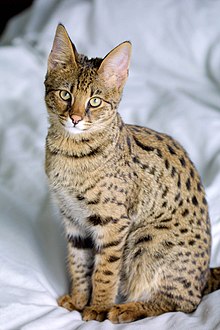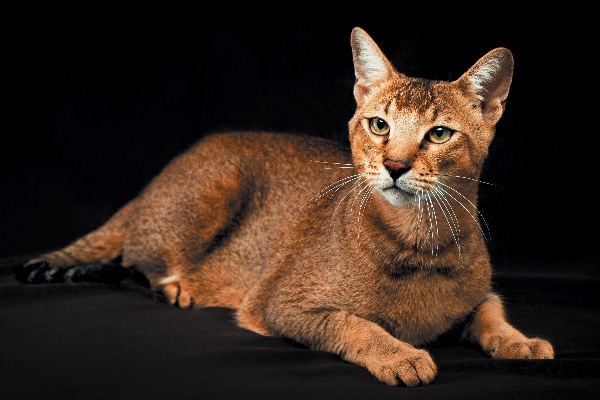______________________________________________________________
Felidae are genetically very similar, and interbreed frequently with each other in the wild. Humans have also bred certain hybrid cats, especially the Savannah, Bengal and Chausie cats, to be domesticated housepets while keeping the exotic look of their wild ancestors.
 |
| Look at all those hybridisation events! (black and red lines). Image from a conference presentation at Tufts Canine and Feline Breeding and Genetics Conference by Dr. William Murphy. |
Savannah cat
Chausie cat
Bengal cat
 |
| Savannah |
 |
| Chausie cat |
 |
| Bengal |
I'm going to mainly talk about savannah cats since those are the ones I'm most interested in. They're generally bred from a female domestic cat (often an Egyptian Mau, ocicat, bengal (another hybrid!) or a domestic shorthair) and a male serval to produce an F1 cat that is 50% serval. This can be backcrossed with a male serval to produce a cat that's 75% serval, but instead these cats are usually backcrossed with domestic cats like so:
 |
| Red means % serval in savannah cats of that generation |
Until at least F4, the males are not fertile, but the females are fertile from F1 onwards, an example of Haldane's Rule: when in the F1 offspring of two different animal races one sex is absent, rare, or sterile, that sex is the heterozygous sex (heterogametic sex). It can get a bit messy around F5 because those fertile F5 males can now be bred with F1 or other generations of female savannahs, rather than breeding them with domestic cats (outcrossing), and this is now generally preferred to maintain breed type (though probably not great for their health...)
Interestingly, more late-generation male savannahs (F5, F6) seem to be sterile lately, which is suggested by the author of the Wikipedia article to be because of the higher percentage serval savannahs are usually made with lately (due to less outcrossing), or because of the Bengal cat DNA from the foundation of the breed. Both of these relate to a higher percentage of nondomestic cat DNA, which I think from the paper I just read by Davis et al 2015 (which I plan to use as an example in a later blog post about how I annotate papers) could be because sterility relates to the presence of nondomestic haplotypes on the X chromosome.
Savannahs are known for being playful, intelligent, energetic, enjoying water, and leaping high, like on top of fridges. Both savannahs and Bengals are known to be vocal, with the savannah sometimes miaowing and sometimes chirping like a serval. However, several cat sanctuaries and organisation warn against buying hybrid cats because they can suddenly become aggressive on reaching maturity and 'unlearn domestication' and start peeing everywhere, leading to an excess of surrenders to shelters. Because it's random which 50% of the DNA comes from which parent, you can't know how wild the cat's temperament will remain. I do wonder - to get a bit science fictiony - if that could be controlled via a gene drive or some sort of manipulation of genomic imprinting so you can silence a certain category of genes (e.g. aggression) if they come from a particular parent (e.g. the wild one). Note: even if we could do that, I'm not saying we should. Just an interesting thought.
Genetics of Hybrid Cat Sterility
Davis et al 2015, in their paper Mechanisms Underlying Mammalian Hybrid Sterility in Two Feline Interspecies Models, looked for genes influencing male sterility in savannahs and bengals as compared to fertile hybrids and their parent species (domestic cats, servals, and asian leopard cats). They hypothesized (apparently this is from the Dobzhansky-Muller model, which I need to look up more about) that sterile hybrids would be enriched for SNP alleles from the wild species rather than the domestic one. I liked this study because not only did it do a GWAS, it also did expression level measurement via RNA-Seq to partially verify the GWAS hits, and sometimes also compared to results from mouse knockout studies. I won't go into all the details from it, but the major points I got from it were as follows.
Most of the candidate hybrid male sterility (HMS) loci show very little amino acid divergence between the domestic and wild cat species - the change seems to be in the regulatory regions
They found associations with male sterility for 5 SNPs in savannahs and 3 in Bengals. These included genes involved in the blood-testis barrier, a glutamate receptor, a Ser/Thr kinase and a transcription factor, as well as AKAP9 which anchors protein kinase A, and a DNA methylase that suggested epigenetic effects. There were two interesting links to cAMP, but that may just be because cAMP is involved in a lot.
The major sterility issues were problems with the blood:testis barrier, with acrosomal (a sperm structure) development, and with transcriptional regulation.
While they say the X chromosome is important in this, they didn't get any statistically significant SNPs on the X chromosome from the GWAS (though they sure try to sneak it in with 'suggestive' and 'approached' significance!). They attribute this to low X SNP density on the array and/or the Large X Effect being especially polygenic due to the long divergence time between the parental species - something I imagine could be investigated using Chausie cats, since they have a divergence time about a third as long (~3 MYA).
 |
| Manhattan plots: too pretty for their own good. |
Here are their graphs comparing the sterile hybrids' testis gene expression to fertile hybrids and parent species. What I gather from that is that in all six groups, more of the X chromosome genes are in the bins for being overexpressed compared to the other type (fertile hybrid, wild parent, domestic cat), whereas the autosomal genes aren't clustered around the left of the graph so aren't generally overexpressed. The consistency between Bengals and Savannahs suggests commonalities in the reason for sterility among the two breeds, and other similarities with mouse suggest it could go even further.
 |
| Ignore my blue writing, if only because it'll be explained in the paper-annotating post. |
Questions*
- Why have cats diverged so little from each other?
- Why do Bengal males become fertile in earlier generations than savannahs?
- Haldane's Rule, and its various proposed answers that open up more questions...
- What are the implications of the relationship between HMS and copy number variation on the X chromosome?
- Why is it X chromosome blocks from the wild parent, rather than the domestic parent, that seem to induce sterility? Is it because these cats are usually more domestic than wild in ancestry? I'm not sure if this data includes 75% servals etc.
- Why are there so few studies in this area?? These cats are cool.
- WHY is the supplemental data in PDF? Please, whoever is responsible for this, whether it's the authors, the journal, or the flying spaghetti monster himself - just put it in a CSV. Thank you.
*some of these questions may well have an answer, but this is what popped into my head.
__________________________________________________________________________________
Finally, have this. Because what's the point of science without a poorly-drawn sketch of a Savannah cat sitting on top of a fridge?




Happy to found this blog. I have some facts related to this blog and I would like to share with all its readers. Definitely it is going to help everyone and aware people with some more knowledgeable points.servals for sale usa
ReplyDeleteI would also motivate just about every person to save this web page for any favorite assistance to assist posted the appearance. Exotic Cat Breeds
ReplyDeleteHello Dear,
ReplyDeleteI Like Your Blog Very Much. I see Daily Your Blog, is A Very Useful For me.
You can also Find f1 savannah sale We are a savannah cat breeder . Specializing in F1 Savannahs and F2 Savannah cats . We have savannah kittens available now for sale from $3,000 +.
Please Visit at: https://www.f1savannahkittens.com/
I’m happy I located this blog! From time to time, students want to cognitive the keys of productive literary essays composing. Your first-class knowledge about this good post can become a proper basis for such people. nice one 婚介
ReplyDelete